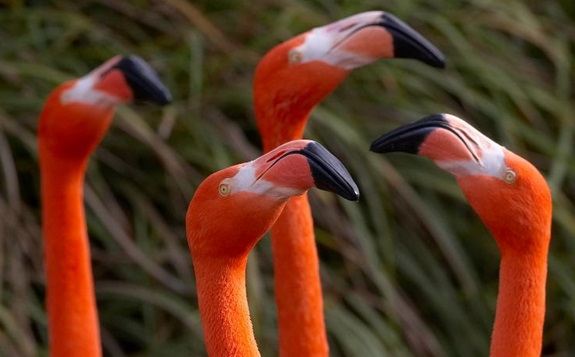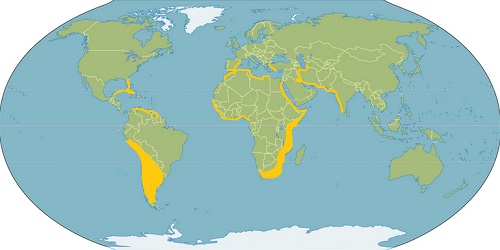o
o
Population and Conservation Status
- Chilean flamingo (Phoenicopterus chilensis) – Near Threatened. The Chilean flamingo breeds erratically and irregularly. The IUCN estimates a total population of 300,000 individuals.
- Caribbean flamingo (Phoenicopterus ruber ruber) – Least Concern. This species has a large range with an increasing population.
- Lesser flamingo (Phoeniconaias minor) – Near Threatened. Decreasing population trend.
- Greater flamingo (Phoenicopterus ruber roseus) – Least Concern. This species has the largest distribution of all species with healthy population growth.
- James’ flamingo (Phoenicoparrus jamesi) – Near Threatened. The IUCN estimates a population of 106,000 individuals with a stable population trend. It is suspected that habitat loss and degradation will cause a decline in numbers in the next 50 years.
- Andean flamingo (Phoenicoparrus andinus) – Vulnerable. This species has undergone a rapid population decline in the past 50 years. The IUCN estimates a population of 39,000 individuals.
Taxonomy
- Kingdom: Animalia
- Phylum: Chordata
- Class: Aves
- Order Phoenicopteriformes
- Family: Phoenicopteridae
- Genus: Phoeniconaias
- Species: Phoeniconaias minor (Lesser Flamingo)
- Genus: Phoenicoparrus
- Species:Phoenicoparrus andinus (Andean Flamingo)
- Species:Phoenicoparrus jamesi (Puna Flamingo or James’ Flamingo)
- Genus: Phoenicopterus
- Species: Phoenicopterus chilensis (Chilean Flamingo)
- Species: Phoenicopterus ruber (Greater Flamingo)
- Subspecies: Phoenicopterus ruber roseus(Greater Flamingo)
- Subspecies:Phoenicopterus ruber ruber (Caribbean Flamingo)
Distribution
- Caribbean flamingo (Phoenicopterus ruber ruber) is distributed throughout the Caribbean islands, Galapagos Islands and northern South America.
- Andean flamingo (Phoenicoparrus andinus) is found in the Andes of Peru, northern Chile, western Bolivia and northwest Argentina.
- James’ flamingo or Puna flamingo (Phoenicoparrus jamesi) has the most restricted distribution of all flamingos. They live in the Andes of Peru, northern Chile, western Bolivia and northwest Argentina.
- Chilean flamingo (Phoenicopterus chilensis) is found on the Pacific and Atlantic coasts of South America in Ecuador, Peru, Chile, Argentina, Uruguay, Paraguay, Bolivia and Brazil.
- Lesser flamingo (Phoeniconaias minor) populations are found mainly in southwestern, eastern and western Africa. Smaller populations are found in India.
- Greater flamingo (Phoenicopterus ruber roseus) has the most widespread distribution of all flamingo species. They can be found in Africa, southern Europe, northwest India and the Middle East.
Habitat
- Flamingos inhabit large, shallow alkaline or saline lakes or lagoons in tropical and subtropical areas. These bodies of water may be inland or near the ocean.
- Some flamingos migrate due to changes in habitat such as availability of food and water. Most flamingos do not migrate.
- Populations such as the Andean flamingo which breed at high altitudes migrate to warmer areas during the winter.
Physical Features
- Flamingo’s pink feathers are due to their diet rich in carotenoid pigments found in algae and crustaceans. The hue of their feathers varies according to diet and species and ranges from pale pink to crimson.
- Chilean flamingos have pale pink feathers while Caribbean flamingos have crimson feathers.
- Males are slightly larger than females.
- Chicks are born with gray or white feathers. Juveniles are gray. They reach their adult coloration one or two years after birth.
- Their legs are longer than their bodies. They have webbing between toes.
- They have long necks with 19 elongated cervical vertebrae.
- Flamingos have yellow eyes. Chicks have gray eyes.
- All flamingos have black flight feathers.
Size and Length
- The greater flamingo is the tallest and heaviest of the flamingo species measuring from 47 to 59 in (1.2 to 1.5 m) and weighing up to 7.7 lb (3.5 kg).
- The lesser flamingo is the smallest and lightest of all species. They measure from 31 to 35 in (80 to 90 cm) and weigh from 2.6 to 6 lb (1.2 to 2.7 kg).
Behavior
- Flamingos are social birds and live in flocks of a few dozen to colonies of thousands of them. The average flock size is 71 birds.
- Flamingos need to run a few paces to gather speed to prepare for flying.
- They fly together in large flocks using formations to take advantage of the wind.
- Flamingos spend up to 30% of their time preening. They use their bills to extract oil from a gland at the base of their tail to waterproof their feathers.
- These birds communicate by loud vocalizations which include a type of nasal honking and grunting. They also communicate by visual displays.
- Flamingos usually stand on one leg.
Reproduction
- Flamingos reach reproductive maturity at around 6 years of age.
- Breeding depends on food supply.
- Breeding is synchronized within a colony. Different colonies may breed at different times of the year.
- Before breeding flamingos perform synchronized ritual displays.
- Both male and female build a nest by pulling mud toward their feet and forming a mound of up to 24 in (60cm) high. Nests are built very close together.
- Clutch size is one, very rarely two. Incubation period is from 27 to 31 days and both male and female take turns incubating the egg.
- Male and female produce a secretion from their digestive track called “milk” produced by the hormone prolactin.
Life Expectancy
- Life expectancy for flamingos is from 30 to 40 years.
Did you know?
- Flamingos excrete salt through salt glands in the nostrils
References and further research
The Animal Aging and Longevity Database – Flamingo


